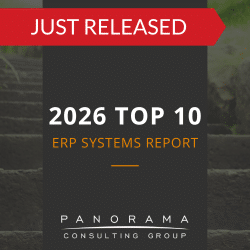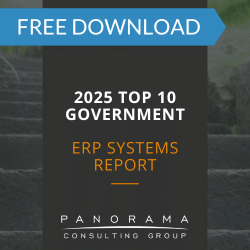- Preparing finance teams for ERP transformation requires early involvement in system design, not just late-stage training and testing.
- ERP resistance from finance teams often stems from systems built around idealized workflows that overlook real-world exceptions and time-sensitive pressures.
- Involving finance leaders in ERP planning helps prevent reporting gaps, compliance risks, and workarounds that erode confidence in the system.
- ERP training for finance teams must go beyond software functionality to include outcome-driven scenarios like audit prep and close acceleration.
Finance teams often find themselves at the center of ERP transformation initiatives—yet too often, they’re the least prepared for what’s coming.
While ERP systems promise tighter controls, faster month-end closes, and richer insights, those benefits rarely materialize without deliberate, early involvement of the finance function.
The fact that finance is responsible for time-sensitive, externally visible outputs, means that even small gaps in system design or process training can have significant financial, reputational, and legal consequences.
This blog is for executives who understand that finance can’t be treated as an afterthought in ERP planning. The finance team’s level of involvement will determine whether the system delivers clean data, timely closes, and audit-ready reporting.
Keep reading to find out if your finance department is prepared for change and how to involve finance leaders in ERP planning.
ERP Training Plan Success Story
We helped this manufacturer implement an ERP training strategy to increase user adoption of its new ERP system.
How to Prepare Finance Teams for ERP Adoption
The first signs of ERP misalignment often surface in finance: month-end close begins to slip, audit trails become harder to trace, and executives question the reliability of reports.
These are symptoms of a deeper issue: the finance team wasn’t adequately involved or prepared during selection and implementation. In many cases, the system was configured around theoretical process maps or IT constraints rather than finance’s operational reality.
For example, core workflows—like revenue recognition, intercompany eliminations, or tax reporting—may have been oversimplified or misinterpreted during requirements gathering sessions.
As a result, finance users end up inheriting workflows that were designed without their input, layered with compliance expectations they had no hand in shaping.
Here are four ways to prepare finance teams for ERP transformation and system adoption:
1. Shift the Narrative From “Users” to “Architects”
A better approach is to . . .
- Include finance in setting project success criteria, especially those tied to compliance, close cycles, and financial visibility.
- Ensure finance plays a lead role in defining data ownership, validation rules, and controls for financial data integrity.
- Give finance direct input into the structure of management reports, audit-ready outputs, and external-facing financial disclosures.
- Ensure finance has visibility into how decisions in operations, procurement, and IT will impact tax compliance, statutory reporting, and internal controls.
Failing to involve stakeholders in the planning phase is a common source of ERP resistance from finance teams. When systems are configured in ways that don’t reflect regulatory requirements or operational realities, finance sees the system as an obstacle rather than an enabler, and resistance follows.
2. Design for the Messy Middle, Not the Ideal State
ERP design workshops tend to gravitate toward future-state process flows. While necessary, these sessions often sanitize the messiness that defines real-world finance work. Exceptions get sidelined, manual steps are glossed over, and reconciliation logic is oversimplified.
Finance teams need systems that work under pressure . . .
- When purchase orders are missing
- When last-minute accruals are flagged during close
- When a new tax rule requires retroactive adjustments
If ERP software isn’t built to accommodate variability and time sensitivity, finance teams fall back on spreadsheets and patch together manual workarounds.
Our ERP implementation consultants often tell clients to create sandbox environments where finance teams can walk through high-pressure cycles—month-end close, budgeting season, external audit prep—using actual historical data.
These scenarios expose where the system will break down or where workarounds might be needed. More importantly, when finance sees that their pain points are being anticipated, their buy-in increases.
3. Prioritize Role-Specific ERP Training for Finance Teams
Even when finance leaders are included in ERP planning, that doesn’t guarantee high user adoption. ERP adoption requires time, repetition, and a shift in mindset—from using the system as a compliance exercise to viewing it as an operational advantage.
Our ERP expert witnesses have analyzed many ERP projects where finance is “trained” on new tools but never fully adopts them. They complete the minimum tasks within the system and then revert to spreadsheets or legacy processes for anything that feels uncomfortable.
So how do you move from training to full adoption?
Generic training rarely works. Finance teams have highly specialized responsibilities that depend on precision and predictability. They don’t just need to know how to post journal entries—they need to understand nuances like the downstream impact of errors and the consistency of cross-ledger entries.
Effective ERP training for finance teams should be . . .
- Tailored to Finance Roles: Training should align with specific responsibilities, such as reconciliations, regulatory reporting, or intercompany transactions.
- Sequenced Around Business Cycles: Programs should follow the rhythm of actual finance work, introducing features in the order they’ll be used (e.g., close procedures before budget planning).
- Framed by Business Outcomes: Training should answer operational questions like “How will this accelerate our month-end close?” or “How do we ensure auditability across legal entities?”.
- Reinforced Over Time: One-time training sessions aren’t enough. Finance teams need recurring refreshers, scenario-based workshops, and access to support as the system evolves.
- Positioned as Ownership, Not Survival: Finance users should be empowered as system stewards, not positioned as passive recipients of change. When they’re trained only to “get by,” they won’t use the system to its full potential.
4. Build in Feedback Loops
Once the system goes live, gaps may emerge that were overlooked during testing:
- Permissions misaligned
- Reports missing
- Reconciliations incomplete
These issues can erode user trust and fuel resistance if left unresolved. The best way to catch and correct these issues is to give finance teams a voice and the authority to suggest post-go-live adjustments.
Our ERP consulting team often advises clients to create a post-go-live governance model where finance has direct input into the system roadmap. This can help restore confidence and drive continued adoption. Examples include a finance-led steering committee, a release prioritization board that ranks system updates based on user impact, or an ERP improvement council focused on continuous improvement.
Learn More About ERP Involvement for Finance Teams
In times of change—economic downturns, acquisitions, leadership shifts—finance needs to lead.
Preparing finance teams for ERP transformation is a strategic imperative. The sooner you start involving them, the sooner your technology investment will deliver what matters: clean financials, faster close cycles, and full confidence in your data.
As independent ERP consultants, we work only for our clients—not for vendors. That means we can focus on what your finance team actually needs. This includes deploying organizational change strategies that are grounded in how finance teams learn and operate under pressure. Contact us to learn more.





![Preparing Finance Teams for ERP Transformation [Are You Involving Them Enough?]](https://www.panorama-consulting.com/wp-content/uploads/2025/06/preparing-finance-teams-for-erp.png)








